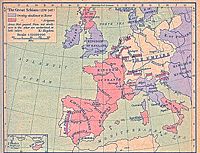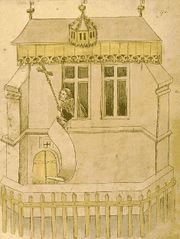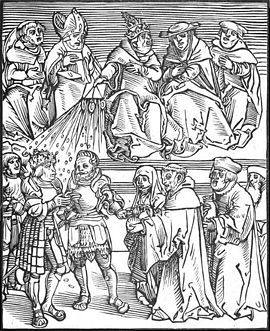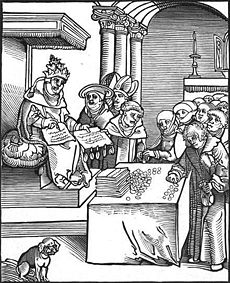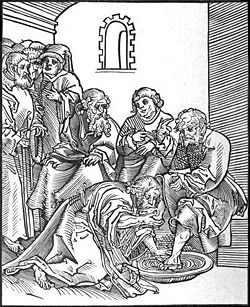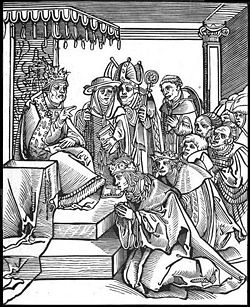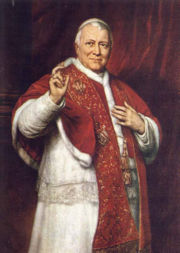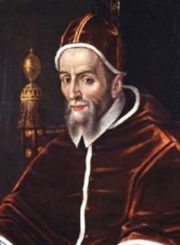Pope
2008/9 Schools Wikipedia Selection. Related subjects: Religious movements, traditions and organizations
Pope of the Roman Catholic Church |
|
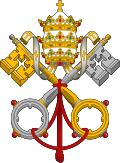 Seal of the Papacy |
|
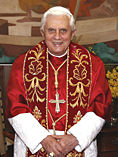 |
|
| Incumbent: Benedict XVI |
|
|---|---|
| Styles | His Holiness |
| Holy Father | |
| Residence | Vatican City |
| First Pope | Traditionally, Saint Peter |
| Formation | First century |
| Website | www.vatican.va |
The Pope (from Latin: "papa" or "father" from Greek πάπας, pápas, "papa", originally written πάππας, páppas, as in Odyssey VI.57; Papa in Italian) is the Bishop of Rome, the leader of the Roman Catholic Church and head of state of Vatican City. The current (265th) pope is Pope Benedict XVI, who was elected April 19, 2005 in papal conclave.
The office of the pope is called the Papacy; his ecclesiastical jurisdiction is called the "Holy See" (Sancta Sedes in Latin) or "Apostolic See" (the latter on the basis that both St. Peter and St. Paul were martyred at Rome).
In addition to his spiritual role, the pope is Head of State of the independent sovereign state of the Vatican City, a city-state entirely enclaved by the city of Rome. Before 1870 the pope's temporal authority extended over a large area of central Italy: the territory of the Papal States. The papacy retained sovereign authority over the Papal States until the Italian unification of 1870; a final political settlement with the Italian government was not reached until the Lateran Treaty of 1929.
For over a thousand years popes played powerful roles in Western Europe, often struggling with monarchs for power over wide-ranging affairs of church and state, crowning emperors (Charlemagne was the first emperor crowned by a pope) and regulating disputes among secular rulers. The Bishop of Rome continued to be nominally allied with and part of the civil structure of the (Byzantine) Roman Empire until the 8th century, when the Donation of Pepin gave Rome and the surrounding area to the full sovereignty of the pope, over which the popes already had been de facto rulers, creating the Papal States that lasted until 1870. For centuries, the forged Donation of Constantine also provided the basis for the papacy's claim of political supremacy over the entire former Western Roman Empire.
Gradually forced to give up secular power, popes have come to focus again almost exclusively on spiritual matters. Over the centuries, popes' claims of spiritual authority have been ever more clearly expressed since the first centuries, culminating in the proclamation of the dogma of papal infallibility for those rare occasions the pope speaks ex cathedra (literally "from the chair (of Peter)") when issuing a solemn definition of faith or morals. The last such occasion was in the year 1950 with the definition of the dogma of the Assumption of Mary.
History
In the early Christian era, Rome and a few other cities had claims on the leadership of worldwide ("Catholic") church. James the Just, known as "the brother of the Lord", served as head of the Jerusalem church, which is still honored as the "Mother Church" in Orthodox tradition. Alexandria had been a center of Jewish learning and became a centre of Christian learning. Rome's first bishop was the disciple Peter, to whom Jesus had given church authority. Paul the Apostle was also martyred there.
Early Christianity (c 30 - 325)
During the first century of the Christian Church (ca. 30-130), the Roman capital became recognized as a Christian centre of exceptional importance; but there are only a few references of that time to recognition of the authoritative primacy of the Roman See outside of Rome. In the Ravenna Document of 13 October 2007, theologians chosen by the Roman Catholic and the Eastern Orthodox Churches stated: "41. Both sides agree ... that Rome, as the Church that 'presides in love' according to the phrase of St Ignatius of Antioch ( To the Romans, Prologue), occupied the first place in the taxis, and that the bishop of Rome was therefore the protos among the patriarchs. They disagree, however, on the interpretation of the historical evidence from this era regarding the prerogatives of the Bishop of Rome as protos, a matter that was already understood in different ways in the first millennium." In addition, in the last years of the first century AD the Church in Rome intervened in the affairs of the Christian Church in Corinth to help solve their internal disputes.
Later in the second century AD, there were further manifestations of Roman authority over other churches. In 189, assertion of the primacy of the Church of Rome may be indicated in Irenaeus of Lyons's Against Heresies (3:3:2): "With [the Church of Rome], because of its superior origin, all the churches must agree... and it is in her that the faithful everywhere have maintained the apostolic tradition." And in 195, Pope Victor I, in what is seen as an exercise of Roman authority over other churches, excommunicated the Quartodecimans for observing Easter on the 14th of Nisan, the date of the Jewish Passover, a tradition handed down by St. John the Evangelist (see Easter controversy). Celebration of Easter on a Sunday, as insisted on by the Pope, is the system that has prevailed (see computus).
Early popes helped spread Christianity and resolve doctrinal disputes.
Nicea to Great Schism (325 - 1054)
With the conversion of Roman Emperor Constantine to Christianity and the Council of Nicea, Christian unity and Rome's primacy were well-established.
After the imperial capital was moved to Constantinople in AD 330 the eastern churches, especially the Bishop of Constantinople, started to assert pre-eminence by virtue of its imperial status.
The First Council of Constantinople (AD 381) suggested strongly that Roman primacy was already asserted; however, it should be noted that, because of the controversy over this claim, the pope did not personally attend this ecumenical council, which was held in the eastern capital of the Roman empire, rather than at Rome. It was not until 440 that Leo the Great more clearly articulated the extension of papal authority as doctrine, promulgating in edicts and in councils his right to exercise "the full range of apostolic powers that Jesus had first bestowed on the apostle Peter". It was at the ecumenical Council of Chalcedon in 451 that Leo I (through his emissaries) stated that he was "speaking with the voice of Peter". At this same council, the Bishop of Constantinople was given a primacy of honour equal to that of the Bishop of Rome, because "Constantinople is the New Rome."
The title of Pope was from the early third century an honorific designation used for any bishop in the West. In the East it was used only for the Bishop of Alexandria. From the 6th century, the imperial chancery of Constantinople normally reserved it for the Bishop of Rome. From the early sixth century it began to be confined in the West to the Bishop of Rome, a practice that was firmly in place by the eleventh century.
After the fall of Rome, the Church served as a source of knowledge, authority, and continuity. The crowning of emperors (Charlemagne was the first emperor crowned by a pope) and regulating disputes among secular rulers also became a function of the Papacy. The Bishop of Rome continued to be nominally allied and part of the civil structure of the Byzantine Empire until the 8th century, when the Donation of Pepin gave Rome and the surrounding area to the full sovereignty of the pope, of which the popes already had been de facto rulers, creating the Papal States that lasted until 1870. For centuries, the forged Donation of Constantine also provided the basis for the papacy's claim of political supremacy over the entire former Western Roman Empire.
Gregory the Great (c 540-604) administered the church with wisdom and stern reform. From an ancient senatorial family, Gregory worked with the prudence, stern judgment, and discipline typical of ancient Roman rule. Theologically, he represents the shift from the classical to the medieval outlook, his popular writings full of dramatic miracles, potent relics, demons, angels, ghosts, and the approaching end of the world.
Gregory's successors were mostly dominated by the exarch or the Eastern emperor. Seeking protection from the Lombards, Stephen II turned from the Emperor and sought protection from the Franks. Pepin the short subdued the Lombards and donated Italian land to the Papacy. When Leo III crowned Charlemagne (800), he established the precedent that no man would be emperor without anointment by a pope.
The low point of the Papacy was 867-1049. The Papacy came under the control of vying political factions. Popes were variously imprisoned, starved, killed, and deposed by force. The family of a certain papal official made and unmade popes for fifty years. The official's great-grandson, Pope John XII, held orgies of debauchery in the Lateran palace. Emperor Otto I of Germany had John accused in an ecclesiastical court, which deposed him and elected a layman as Pope Leo VIII. John mutilated the Imperial representatives in Rome and had himself reinstated as Pope. Conflict between the Emperor and the papacy continued, and eventually dukes in league with the emperor were buying bishops and popes almost openly.
In 1049, Leo IX became pope, at last a pope with the character to face the papacy's problems. He traveled to the major cities of Europe to deal with the church's moral problems firsthand, notably the sale of church offices or services (simony) and clerical marriage and concubinage. With his long journey, he restored the prestige of the Papacy in the north.
Great Schism to Reformation (1054 to 1517)
The East and West churches split definitively in 1054. This split was caused more by political events than by slight diversities of creed. Popes had galled the emperors by siding with the king of the Franks, crowning a rival Roman emperor, appropriating the exarchate of Ravenna, and driving into Greek Italy.
In the Middle Ages, popes struggled with monarchs over power.
Popes also contended with the cardinals, who sometimes attempted to assert the authority of councils over the pope's. Conciliar theory holds that the supreme authority of the church lies with a General Council, not with the pope. Its foundations were laid early in the 13th century, and it culminated in the 15th century. The failure of the conciliar theory to win general acceptance after the 15th century is taken as a factor in the Protestant Reformation.
Various antipopes challenged papal authority, especially during the Western Schism (1378 - 1417).
Reformation to present (1517 to today)
Protestant Reformers criticized the Papacy as corrupt and characterized the pope as the antichrist.
Popes instituted the Catholic Reformation (1560 - 1648), which addressed challenges of the Protestant Reformation and instituted internal reforms.
Gradually forced to give up secular power, popes focused on spiritual issues.
The pope's claims of spiritual authority have been ever more clearly expressed since the first centuries. In the 19th century, the church proclaimed the dogma of papal infallibility for those rare occasions the pope speaks ex cathedra (literally "from the chair (of Peter)") when issuing a solemn definition of faith or morals.
In 1950, the pope defined the Assumption of Mary as dogma, the only time that a pope has spoken ex cathedra since papal infallibility was explicitly declared.
The Petrine Doctrine is still controversial as an issue of doctrine that continues to divide the eastern and western churches as well as separating Protestants from Rome.
The pope in Roman Catholic theology
The dogmas and traditions of the Roman Catholic Church teach that the institution of the papacy was first mandated by Biblical passages:
| “ | Matt.16:18-19: "And I also say to you that you are Peter, and upon this rock I will build my church, and the gates of the netherworld will not prevail against it. I will give you the keys of the kingdom of heaven; whatever you bind on earth will be bound in heaven, and whatever you loose on earth will be loosed in heaven." Isaiah 22:20-22: "On that day I will summon my servant Eliakim, son of Hilkiah; I will clothe him with your robe, and gird him with your sash, and give over to him your authority. He shall be a father to the inhabitants of Jerusalem, and to the house of Judah. I will place the key of the House of David on his shoulder; when he opens, no one shall shut, when he shuts, no one shall open." (shows a parallel to Matthew 16:18-20) John 21:15-17: "..Jesus said to Simon Peter, "Simon, son of John, do you love me more than these?" He said to him, "Yes, Lord, you know that I love you." He said to him, "Feed my lambs." He then said to him a second time, "Simon, son of John, do you love me?" He said to him, "Yes, Lord, you know that I love you." He said to him, "Tend my sheep." He said to him the third time, "Simon, son of John, do you love me?" Peter was distressed that he had said to him a third time, "Do you love me?" and he said to him, "Lord, you know everything; you know that I love you." (Jesus) said to him, "Feed my sheep." Luke 12:41: "Then Peter said, "Lord, is this parable meant for us or for everyone?" And the Lord replied, "Who, then, is the faithful and prudent steward whom the master will put in charge of his servants to distribute (the) food allowance at the proper time?" (Feeding theme appears again here) Luke 22:31-32: "Simon, Simon, behold Satan has demanded to sift all of you like wheat, but I have prayed that your own faith may not fail; and once you have turned back, you must strengthen your brothers." |
” |
For Catholic Apologists the most important passage used to defend the Papacy is Matthew 16:18-19. Catholics believe that this passage shows Jesus establishing his church on the shoulders of Simon son of John, whom Jesus re-named Peter (meaning rock). Thus Peter was the rock upon which Christ's Church was built, therefore Jesus established a head to his earthly Church, calling for a successor to that head and thus the Papacy was established.
However, this interpretation of events is challenged by non-Catholics. Some say it was Peter's confession of faith that Jesus referred to. However, others propose that Jesus never called Peter rock at all but instead he was called "small stone".
The names "Petros" and "Peter" are Greek and Latin translations of the Aramaic word "Cephas," spoken by Jesus Christ. "Cephas" means "rock."
The Aramaic word for small stone is "Evna" John (1:41) is scriptural proof that, in the original Aramaic language, Jesus did not name Simon "Evna" (small stone) Christ named Simon "Cephas" (rock):
| “ | John 1:41-42: ”He findeth first his brother Simon, and saith to him: We have found the Messias, which is, being interpreted, the Christ. And he brought him to Jesus. And Jesus looking upon him, said: Thou art Simon the son of Jona: thou shalt be called Cephas, which is interpreted Peter.” | ” |
For the above Scripture to imply that Simon's new name was meant to be understood as "small stone," the writer would use the Latin word "calculus" which means "small stone." However, the Scripture explicitly states that "Cephas" is interpreted as "Peter." "Peter" means "rock" in Latin.
The translation of Matthew's Gospel into Greek named Simon "Petros" rather than "petra" because "petra" is a feminine noun and unsuitable for a man's name. The translator had no problem substituting the masculine form "Petros" because in Koine Greek, which was the dialect in use at the time of the New Testament, "petra" and "petros" both meant the same thing, "rock."
"Petros" and "petras" meant "small stone" and "large rock" in some ancient Greek poetry, centuries before the time of Christ, but that distinction had disappeared from the language by the time Matthew’s Gospel was rendered in Greek. As Greek scholars—even non-Catholic ones—admit, the words "petros" and "petra" were synonyms in first century Greek.
The difference between "petros" and "petras" can only be found in Attic Greek, but the New Testament was written in Koine Greek—an entirely different dialect. In Koine Greek, both "petros" and "petra" simply meant "rock." If Jesus had wanted to call Simon a small stone, the translation of Christ's Aramaic into Greek would have been "lithos," which means "small stone" in Koine Greek.
Simon-Peter's Aramaic name given by Christ is also preserved at later points in the New Testament:
| “ | 1 Corinthians 15:1-5: “For I delivered unto you first of all that which also I received: that Christ died for our sins according to the scriptures; and that he was buried; and that he hath been raised on the third day according to the scriptures; and that he appeared to Cephas; then to the twelve” (1Cor 15:3) | ” |
Isaiah 22:22 is used to show the Old Testament connection to the "keys." The Bible further explains the position of Eliakim in Isaiah in the following:
"Then Eliakim son of Hilkiah, who was in charge of the palace..." ( 2 Kings 18:37)
Some Jewish commentators of the Old Testament understood Numbers 23:9 in a manner similar to Peter with this commentary from the Jewish Encyclopedia on Peter regarding Abraham:
"Upon Abraham as top of the rocks God said I shall build my kingdom"
The reference to the "keys of the kingdom of heaven" here are the basis for the symbolic keys often found in Catholic papal symbolism, such as in the Vatican Coat of Arms (see below).
Election, death and abdication
Election
The pope was originally chosen by those senior clergymen resident in and near Rome. In 1059 the electorate was restricted to the Cardinals of the Holy Roman Church, and the individual votes of all Cardinal Electors were made equal in 1179. Pope Urban VI, elected 1378, was the last pope who was not already a cardinal at the time of his election. Canon law requires that if a layman or non-bishop is elected, he receives episcopal consecration from the Dean of the College of Cardinals before assuming the Pontificate. Under present canon law, the pope is elected by the cardinal electors, comprising those cardinals who are under the age of 80.
The Second Council of Lyons was convened on May 7, 1274, to regulate the election of the pope. This Council decreed that the cardinal electors must meet within ten days of the pope's death, and that they must remain in seclusion (see Papal conclave) until a pope has been elected; this was prompted by the three-year Sede Vacante following the death of Pope Clement IV in 1268. By the mid-sixteenth century, the electoral process had more or less evolved into its present form, allowing for alteration in the time between the death of the pope and the meeting of the cardinal electors.
Traditionally, the vote was conducted by acclamation, by selection (by committee), or by plenary vote. Acclamation was the simplest procedure, consisting entirely of a voice vote, and was last used in 1621. Pope John Paul II abolished vote by acclamation and by selection by committee, and henceforth all Popes will be elected by full vote of the Sacred College of Cardinals by ballot (see Papal election).
The election of the pope almost always takes place in the Sistine Chapel, in a sequestered meeting called a " conclave" (so called because the cardinal electors are theoretically locked in, cum clave, until they elect a new pope). Three cardinals are chosen by lot to collect the votes of absent cardinal electors (by reason of illness), three are chosen by lot to count the votes, and three are chosen by lot to review the count of the votes. The ballots are distributed and each cardinal elector writes the name of his choice on it and pledges aloud that he is voting for "one whom under God I think ought to be elected" before folding and depositing his vote on a plate atop a large chalice placed on the altar (in the 2005 conclave, a special urn was used for this purpose instead of a chalice and plate). The plate is then used to drop the ballot into the chalice, making it difficult for any elector to insert multiple ballots. Before being read, the number of ballots are counted while still folded; if the total number of ballots does not match the number of electors, the ballots are burned unopened and a new vote is held. Otherwise, each ballot is read aloud by the presiding Cardinal, who pierces the ballot with a needle and thread, stringing all the ballots together and tying the ends of the thread to ensure accuracy and honesty. Balloting continues until a Pope is elected by a two-thirds majority (with the promulgation of Universi Dominici Gregis in 1996, a simple majority after a deadlock of twelve days was allowed, but this was revoked by Pope Benedict XVI by motu proprio in 2007).
One of the most famous aspects of the papal election process is the means by which the results of a ballot are announced to the world. Once the ballots are counted and bound together, they are burned in a special stove erected in the Sistine Chapel, with the smoke escaping through a small chimney visible from St. Peter's Square. The ballots from an unsuccessful vote are burned along with a chemical compound in order to produce black smoke, or fumata nera. (Traditionally, wet straw was used to help create the black smoke, but a number of "false alarms" in past conclaves have brought about this concession to modern chemistry.) When a vote is successful, the ballots are burned alone, sending white smoke (fumata bianca) through the chimney and announcing to the world the election of a new pope. At the end of the conclave that elected Pope Benedict XVI, church bells were also rung to signal that a new pope had been chosen.
The Dean of the College of Cardinals then asks the cardinal who has been successfully-elected two solemn questions. First he asks, "Do you freely accept your election?" If he replies with the word "Accepto", his reign as Pope begins at that instant, not at the inauguration ceremony several days afterward. The Dean then asks, "By what name shall you be called?" The new pope then announces the regnal name he has chosen for himself. (If the Dean himself is elected pope, the Vice Dean performs this duty).
The new pope is led through the "Door of Tears" to a dressing room in which three sets of white papal vestments (immantatio) await: small, medium, and large. Donning the appropriate vestments and reemerging into the Sistine Chapel, the new pope is given the " Fisherman's Ring" by the Cardinal Camerlengo, whom he first either reconfirms or reappoints. The pope then assumes a place of honour as the rest of the cardinals wait in turn to offer their first "obedience" (adoratio) and to receive his blessing.
The senior Cardinal Deacon then announces from a balcony over St. Peter's Square the following proclamation: Annuntio vobis gaudium magnum! Habemus Papam! ("I announce to you a great joy! We have a pope!"). He then announces the new pope's Christian name along with the new name he has adopted as his regnal name.
Until 1978 the pope's election was followed in a few days by the Papal Coronation. A procession with great pomp and circumstance formed from the Sistine Chapel to St. Peter's Basilica, with the newly elected pope borne in the sedia gestatoria. There, after a solemn Papal Mass, the new pope was crowned with the triregnum (papal tiara) and he gave for the first time as pope the famous blessing Urbi et Orbi ("to the City [Rome] and to the World"). Another renowned part of the coronation was the lighting of a bundle of flax at the top of a gilded pole, which would flare brightly for a moment and then promptly extinguish, with the admonition Sic transit gloria mundi ("Thus passes worldly glory"). A similar sombre warning against papal hubris made on this occasion was the ritual exclamation "Annos Petri non videbis", reminding the newly crowned Pope that he would not live to see his rule lasting as long as that of St. Peter, who according to tradition headed the church for 35 years and has thus far been the longest reigning Pope in the history of the Catholic Church.
A traditionalist Catholic belief claims the existence of the Papal Oath (not to be confused with the Oath Against Modernism mandated by Pope Pius X), which the popes from John Paul I on are said to have refused to swear, but there is no reliable authority for this claim.
The Latin term sede vacante ("vacant seat") refers to a papal interregnum, the period between the death of a pope and the election of his successor. From this term is derived the term sedevacantism, which designates a category of dissident Catholics who maintain that there is no canonically and legitimately elected Pope, and that there is therefore a Sede Vacante. One of the most common reasons for holding this belief is the idea that the reforms of the Second Vatican Council and especially the replacement of the Tridentine Mass with the Mass of Paul VI are heretical, and that, per the dogma of papal infallibility, it is impossible for a valid Pope to have done these things. Secevacantists are considered to be schismatics by the mainstream Roman Catholic Church.
For centuries, the papacy was an institution dominated by Italians. Prior to the election of the Polish cardinal Karol Wojtyla as Pope John Paul II in 1978, the last non-Italian was Pope Adrian VI of the Netherlands, elected in 1522. John Paul II was followed by the German-born Benedict XVI, leading some to believe the Italian domination of the papacy to be over.
Death
The current regulations regarding a papal interregnum — that is, a sede vacante ("vacant seat") — were promulgated by John Paul II in his 1996 document Universi Dominici Gregis. During the "Sede Vacante", the Sacred College of Cardinals, composed of the pope's principal advisors and assistants, is collectively responsible for the government of the Church and of the Vatican itself, under the direction of the Cardinal Chamberlain; however, canon law specifically forbids the cardinals from introducing any innovation in the government of the Church during the vacancy of the Holy See. Any decision that requires the assent of the pope has to wait until the new pope has been elected and accepts office.
It has long been claimed that a pope's death is officially determined by the Cardinal Chamberlain by gently tapping the late pope's head thrice with a silver hammer and calling his birth name three times, though this is disputed and has never been confirmed by the Vatican; there is general agreement that even if this procedure ever actually occurred, it was likely not employed upon the death of John Paul II. A doctor may or may not have already determined that the pope had died before this point. The Cardinal Chamberlain then retrieves the Ring of the Fisherman. Usually the ring is on the pope's right hand. But in the case of Paul VI, he had stopped wearing the ring during the last years of his reign. In other cases the ring might have been removed for medical reasons. The Chamberlain cuts the ring in two in the presence of the Cardinals. The deceased pope's seals are defaced, to keep them from ever being used again, and his personal apartment is sealed.
The body then lies in state for a number of days before being interred in the crypt of a leading church or cathedral; the popes of the 20th century were all interred in St. Peter's Basilica. A nine-day period of mourning (novem dialis) follows after the interment of the late Pope. Vatican tradition holds that no autopsy is to be performed on the body of a dead Pope.
Abdication
The Code of Canon Law 332 §2 states, "If it happens that the Roman Pontiff resigns his office, it is required for validity that the resignation is made freely and properly manifested but not that it is accepted by anyone."
This right has been exercised by Pope Celestine V in 1294 and Pope Gregory XII in 1409, Gregory XII being the last to do so.
It was widely reported in June and July 2002 that Pope John Paul II firmly refuted the speculation of his resignation using Canon 332, in a letter to the Milan daily newspaper Corriere della Sera.
Nevertheless, 332 §2 caused speculation that:
- Pope John Paul II would have resigned as his health failed, or
- a properly manifested legal instrument had been prepared which effected his resignation if he could not perform his duties.
Pope John Paul II, however, did not resign. He died on 2 April 2005 after a long period of ill-health and was buried on 8 April 2005. After his death, it was reported in his last will and testament that he considered abdicating in 2000 as he neared his 80th birthday. That portion of the will, however, is unclear and others interpret it differently.
Titles
| Styles of The Pope |
|
 |
|
| Reference style | His Holiness |
| Spoken style | Your Holiness |
| Religious style | Holy Father |
| Posthumous style | NA |
Current
The titles of the Pope, in the order they are used in the Annuario Pontificio:
-
- Bishop of Rome
- Vicar of Christ
- Successor of the Prince of the Apostles
- Supreme Pontiff of the Universal Church
- Primate of Italy
- Archbishop and Metropolitan of the Roman Province
- Sovereign of the State of the Vatican City
- Servant of the Servants of God
Former
-
- Patriarch of the West (dropped 2006)
- Vicar of the Apostolic See
- Vicar of Peter
Forms of address
- "Your Holiness"
- "Holy Father"
- "Il Papa"
History
Marcellinus (d. 304) is the first Bishop of Rome whom sources show used the title of pope. In the 11th century, after the East-West Schism, Gregory VII declared the term "Pope" to be reserved for the Bishop of Rome.
Early bishops occupying the See of Rome were designated "Vicar of Peter" (St. Peter being considered "Prince of the Apostles" or leader of the apostolic Church); for later popes the more authoritative-sounding Vicar of Christ was substituted. The designation "Vicar of Christ" was first used by the Roman Synod of 495 to refer to Pope Gelasius I, an advocate of papal supremacy among the patriarchs. The title "Vicar of Christ" refers to the Pope's claims of divine commission. The Christian Church prior to Constantine reserved the titles, "Vicar of Christ" and "Vicar of the Lord" exclusively for the Holy Spirit, whom Jesus sent to His Apostles to complete their training (John 16:12-15). Tertullian demonstrates this fact in the following quotes:
"Grant, then, that all have erred; that the apostle was mistaken in giving his testimony; that the Holy Ghost ... He, the Steward of God, the Vicar of Christ ..."
"For what kind of (supposition) is it, that, while the devil is always operating and adding daily to the ingenuities of iniquity, the work of God should either have ceased, or else have desisted from advancing? whereas the reason why the Lord sent the Paraclete was, that, since human mediocrity was unable to take in all things at once, discipline should, little by little, be directed, and ordained, and carried on to perfection, by that Vicar of the Lord, the Holy Spirit."
The Second Vatican Council confirmed the titles "Vicar of Christ" and "Successor of Peter" as titles of the pope.
The use of the term "Supreme Pontiff" ( Pontifex Maximus) by the pope can be traced back to the end of the fourth century. This ancient title of the Roman High-Priest, whose origins date from the foundation of Rome, was assumed by the Bishops of Rome after being relinquished by the Emperor Gratian. The term has also been applied to other metropolitan bishops, although examples are limited (see Pontifex Maximus). It was in the eleventh century that the title came to be applied exclusively to the Bishop of Rome. The addition of the phrase "of the Universal Church" is a more recent alteration of this title.
Finally, the title attached to the pope, "Servant of the Servants of God", although used by Church leaders including St. Augustine and St. Benedict, was first used by Pope St. Gregory the Great in his dispute with the Patriarch of Constantinople after the latter assumed the title Ecumenical Patriarch. It was not reserved for the pope until the thirteenth century. The documents of Vatican II reinforced the understanding of this title as a reference to the pope's role as a function of collegial authority, in which the Bishop of Rome serves the world's bishops.
The titles "Primate of Italy", "Archbishop and Metropolitan of the Roman province", and "Sovereign of the State of the Vatican City" are references to the legal and canonical authority of the pope as defined by the laws of the Church and the Lateran Treaty of 1929.
The pope's signature is usually in the format NN. PP. x (e.g., Pope Paul VI signed his name as "Paulus PP. VI"), the "PP." standing for Papa ("Pope"), and his name is frequently accompanied in inscriptions by the abbreviation Pont. Max. or P.M. (abbreviation of the Latin title Pontifex Maximus, usually translated as "Supreme Pontiff"). The signature of papal bulls is customarily NN. Episcopus Ecclesiae Catholicae ("NN. Bishop of the Catholic Church"), while the heading is NN. Episcopus Servus Servorum Dei ("NN. Bishop and Servant of the Servants of God"). Other titles used in some official capacity in the past include Summus Pontifex ("Highest Pontiff"), Sanctissimus Pater and Beatissimus Pater ("Most Holy Father" and "Most Blessed Father"), Sanctissimus Dominus Noster ("Our Most Holy Lord"), and, in the Medieval period, Dominus Apostolicus ("Apostolic Lord"). This title, however, was not abandoned altogether: the pope is still referred to as "Dominum Apostolicum" in the Latin version of the Litany of the Saints, a solemn Catholic prayer. Writing informally, Catholics will often use the abbreviation H.H. (His Holiness), as in H.H., Benedict XVI.
The pope's official seat or cathedral is the Basilica of St. John Lateran, and his official residence is the Palace of the Vatican. He also possesses a summer palace at Castel Gandolfo (situated on the site of the ancient city-state Alba Longa). Historically, the official residence of the Pope was the Lateran Palace, donated by the Roman Emperor Constantine the Great.
The Pope's ecclesiastical jurisdiction (the Holy See) is distinct from his secular jurisdiction (Vatican City). It is the Holy See which conducts international relations; for hundreds of years, the papal court (the Roman Curia) has functioned as the government of the Catholic Church.
The names "Holy See" and "Apostolic See" are in ecclesiastical terminology the ordinary jurisdiction of the Bishop of Rome (including the Roman Curia); the pope's various honours, powers, and privileges within the Catholic Church and the international community derive from his Episcopate of Rome in lineal succession from the Apostle St. Peter (see Apostolic Succession). Consequently, Rome has traditionally occupied a central position in the Catholic Church, although this is not necessarily so. The pope derives his Pontificate from being Bishop of Rome but is not required to live there; according to the Latin formula ubi Papa, ibi Curia, wherever the Pope resides is the central government of the Church, provided that the pope is Bishop of Rome. As such, between 1309 and 1378, the popes lived in Avignon (see Avignon Papacy), a period often called the Babylonian Captivity in allusion to the Biblical exile of Israel.
The title "Patriarch of the West" did not appear in the 2006 pontifical yearbook, and this led to considerable media speculation. The title Patriarch of the West was first used by Pope Theodore in 642, and was only used occasionally. Indeed, it did not begin to appear in the pontifical yearbook until 1863. On 22 March 2006, the Vatican released a statement explaining this omission on the grounds of expressing a "historical and theological reality" and of "being useful to ecumenical dialogue". The title Patriarch of the West symbolized the pope's special relationship with, and jurisdiction over, the Latin Church — and the omission of the title neither symbolizes in any way a change in this relationship, nor distorts the relationship between the Holy See and the Eastern Churches, as solemnly proclaimed by Vatican II.
Since in the Eastern Churches the title "pope" does not unambiguously refer to the Bishop of Rome, within them the construction "Pope of Rome" is frequently used whether they are in communion with Rome or not.
Regalia and insignia
- " Triregnum", also called the "tiara" or "triple crown", represents the pope's three functions as "supreme pastor", "supreme teacher" and "supreme priest". Recent popes have not, however, worn the triregnum, though it remains the symbol of the papacy and has not been abolished. In liturgical ceremonies Popes wear an episcopal mitre (an erect cloth hat).
- Pastoral Staff topped by a crucifix, a custom established before the 13th century (see papal cross).
- Pallium, or pall, a circular band of fabric worn around the neck over the chasuble. It forms a yoke about the neck, breast and shoulders and has two pendants hanging down in front and behind, and is ornamented with six crosses. Previously, the pallium worn by the pope was identical to those he granted to the primates, but in 2005 Pope Benedict XVI began to use a distinct papal pallium that is larger than the primatial, and was adorned with red crosses instead of black.
- "Keys to the Kingdom of Heaven", the image of two keys, one gold and one silver. The silver key symbolizes the power to bind and loose on Earth, and the gold key the power to bind and loose in Heaven.
- Ring of the Fisherman, a gold ring decorated with a depiction of St. Peter in a boat casting his net, with the name of the reigning Pope around it.
- Umbraculum (better known in the Italian form ombrellino) is a canopy or umbrella consisting of alternating red and gold stripes, which used to be carried above the pope in processions.
- Sedia gestatoria, a mobile throne carried by twelve footmen (palafrenieri) in red uniforms, accompanied by two attendants bearing flabella (fans made of white ostrich feathers), and sometimes a large canopy, carried by eight attendants. The use of the flabella was discontinued by Pope John Paul I. The use of the sedia gestatoria was discontinued by Pope John Paul II, being replaced by the so-called Popemobile.
In heraldry, each pope has his own Papal Coat of Arms. Though unique for each pope, the arms are always surmounted by the aforementioned two keys in saltire (i.e., crossed over one another so as to form an X) behind the escutcheon (shield) (one silver key and one gold key, tied with a red cord), and above them a silver triregnum with three gold crowns and red infulae ( lappets—two strips of fabric hanging from the back of the triregnum which fall over the neck and shoulders when worn). This is blazoned: "two keys in saltire or and argent, interlacing in the rings or, beneath a tiara argent, crowned or"). With the recent election of Benedict XVI in 2005, his personal coat of arms eliminated the papal tiara; a mitre with three horizontal lines is used in its place, with the pallium, a papal symbol of authority more ancient than the tiara, the use of which is also granted to metropolitan archbishops as a sign of communion with the See of Rome, was added underneath of the shield. The distinctive feature of the crossed keys behind the shield was maintained. The omission of the tiara in the Pope's personal coat of arms, however, did not mean the total disappearance of it from papal heraldry, since the coat of arms of the Holy See was kept unaltered.
The flag most frequently associated with the pope is the yellow and white flag of Vatican City, with the arms of the Holy See (blazoned: "Gules, two keys in saltire or and argent, interlacing in the rings or, beneath a tiara argent, crowned or") on the right-hand side (the "fly") in the white half of the flag (the left-hand side—the "hoist"—is yellow). The pope's escucheon does not appear on the flag. This flag was first adopted in 1808, whereas the previous flag had been red and gold, the traditional colors of the papacy. Although Pope Benedict XVI replaced the triregnum with a mitre on his personal coat of arms, it has been retained on the flag.
Status and authority
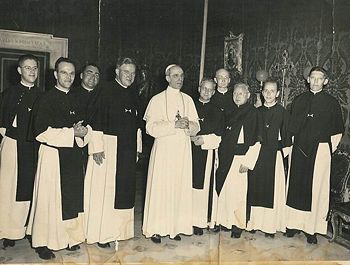
First Vatican Council
The status and authority of the Pope in the Catholic Church was dogmatically defined by the First Vatican Council on 18 July 1870. In its Dogmatic Constitution of the Church of Christ, the Council established the following canons:
"If anyone says that the blessed Apostle Peter was not established by the Lord Christ as the chief of all the apostles, and the visible head of the whole militant Church, or, that the same received great honour but did not receive from the same our Lord Jesus Christ directly and immediately the primacy in true and proper jurisdiction: let him be anathema.
If anyone says that it is not from the institution of Christ the Lord Himself, or by divine right that the blessed Peter has perpetual successors in the primacy over the universal Church, or that the Roman Pontiff is not the successor of blessed Peter in the same primacy, let him be anathema.
If anyone thus speaks, that the Roman Pontiff has only the office of inspection or direction, but not the full and supreme power of jurisdiction over the universal Church, not only in things which pertain to faith and morals, but also in those which pertain to the discipline and government of the Church spread over the whole world; or, that he possesses only the more important parts, but not the whole plenitude of this supreme power; or that this power of his is not ordinary and immediate, or over the churches altogether and individually, and over the pastors and the faithful altogether and individually: let him be anathema.
We, adhering faithfully to the tradition received from the beginning of the Christian faith, to the glory of God, our Saviour, the elevation of the Catholic religion and the salvation of Christian peoples, with the approbation of the sacred Council, teach and explain that the dogma has been divinely revealed: that the Roman Pontiff, when he speaks ex cathedra, that is, when carrying out the duty of the pastor and teacher of all Christians by virtue of his supreme apostolic authority he defines a doctrine of faith or morals to be held by the universal Church, through the divine assistance promised him in blessed Peter, operates with that infallibility with which the divine Redeemer wished that His church be instructed in defining doctrine on faith and morals; and so such definitions of the Roman Pontiff from himself, but not from the consensus of the Church, are unalterable. But if anyone presumes to contradict this definition of Ours, which may God forbid: let him be anathema."
Second Vatican Council
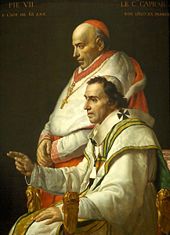
In its Dogmatic Constitution on the Church (1964), the Second Vatican Council declared:
"Among the principal duties of bishops the preaching of the Gospel occupies an eminent place. For bishops are preachers of the faith, who lead new disciples to Christ, and they are authentic teachers, that is, teachers endowed with the authority of Christ, who preach to the people committed to them the faith they must believe and put into practice, and by the light of the Holy Spirit illustrate that faith. They bring forth from the treasury of Revelation new things and old, making it bear fruit and vigilantly warding off any errors that threaten their flock. Bishops, teaching in communion with the Roman Pontiff, are to be respected by all as witnesses to divine and Catholic truth. In matters of faith and morals, the bishops speak in the name of Christ and the faithful are to accept their teaching and adhere to it with a religious assent. This religious submission of mind and will must be shown in a special way to the authentic magisterium of the Roman Pontiff, even when he is not speaking ex cathedra; that is, it must be shown in such a way that his supreme magisterium is acknowledged with reverence, the judgments made by him are sincerely adhered to, according to his manifest mind and will. His mind and will in the matter may be known either from the character of the documents, from his frequent repetition of the same doctrine, or from his manner of speaking.
… this infallibility with which the Divine Redeemer willed His Church to be endowed in defining doctrine of faith and morals, extends as far as the deposit of Revelation extends, which must be religiously guarded and faithfully expounded. And this is the infallibility which the Roman Pontiff, the head of the college of bishops, enjoys in virtue of his office, when, as the supreme shepherd and teacher of all the faithful, who confirms his brethren in their faith, by a definitive act he proclaims a doctrine of faith or morals. And therefore his definitions, of themselves, and not from the consent of the Church, are justly styled irreformable, since they are pronounced with the assistance of the Holy Spirit, promised to him in blessed Peter, and therefore they need no approval of others, nor do they allow an appeal to any other judgment. For then the Roman Pontiff is not pronouncing judgment as a private person, but as the supreme teacher of the universal Church, in whom the charism of infallibility of the Church itself is individually present, he is expounding or defending a doctrine of Catholic faith. The infallibility promised to the Church resides also in the body of Bishops, when that body exercises the supreme magisterium with the successor of Peter. To these definitions the assent of the Church can never be wanting, on account of the activity of that same Holy Spirit, by which the whole flock of Christ is preserved and progresses in unity of faith."
Political role
| Sovereign of the State of the Vatican City |
|
 Coat of Arms of the Vatican |
|
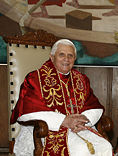 |
|
| Incumbent: Benedict XVI |
|
|---|---|
| Style | His Holiness |
| Residence | Papal Palace |
| First Sovereign | Pope Pius XI |
| Formation | February 11, 1929 |
| Website | http://www.va |
Though the progressive Christianisation of the Roman Empire in the fourth century did not confer upon bishops civil authority within the state, the gradual withdrawal of imperial authority during the fifth century left the pope the senior imperial civilian official in Rome, as bishops were increasingly directing civil affairs in other cities of the Western Empire. This status as a secular and civil ruler was vividly displayed by Pope Leo I's confrontation with Attila in 452. The first expansion of papal rule outside of Rome came in 728 with the Donation of Sutri, which in turn was substantially increased in 754, when the Frankish ruler Pippin the Younger gave to the pope the land from his conquest of the Lombards. The pope may have utilized the forged Donation of Constantine to gain this land, which formed the core of the Papal States. This document, accepted as genuine until the 1400s, states that Constantine I placed the entire Western Empire of Rome under papal rule. In 800 Pope Leo III crowned the Frankish ruler Charlemagne as Roman Emperor, a major step toward establishing what later became known as the Holy Roman Empire; from that date onward the popes claimed the prerogative to crown the Emperor, though the right fell into disuse after the coronation of Charles V in 1530. Pope Pius VII was present at the coronation of Napoleon I in 1804, but did not actually perform the crowning. As mentioned above, the pope's sovereignty over the Papal States ended in 1870 with their annexation by Italy.
Popes like Alexander VI, an ambitious if spectacularly corrupt politician, and Pope Julius II, a formidable general and statesman, were not afraid to use power to achieve their own ends, which included increasing the power of the papacy. This political and temporal authority was demonstrated through the papal role in the Holy Roman Empire (especially prominent during periods of contention with the Emperors, such as during the Pontificates of Pope Gregory VII and Pope Alexander III). Papal bulls, interdict, and excommunication (or the threat thereof) have been used many times to increase papal power. The Bull Laudabiliter in 1155 authorized Henry II of England to invade Ireland. In 1207, Innocent III placed England under interdict until King John made his kingdom a fiefdom to the Pope, complete with yearly tribute, saying, "we offer and freely yield...to our lord Pope Innocent III and his catholic successors, the whole kingdom of England and the whole kingdom of Ireland with all their rights and appurtenences for the remission of our sins". The Bull Inter Caeteras in 1493 led to the Treaty of Tordesillas in 1494, which divided the world into areas of Spanish and Portuguese rule. The Bull Regnans in Excelsis in 1570 excommunicated Elizabeth I of England and declared that all her subjects were released from all allegiance to her. The Bull Inter Gravissimas in 1582 established the Gregorian Calendar.
Objections to the papacy
The Pope's claim of being the Supreme Pontiff of the Universal Church is recognized as dogmatic and not considered open to debate within the Roman Church. The First Vatican Council anathematized all who dispute the pope's claims of primacy of honour and of jurisdiction.
The Pope's claim to authority is disputed outside the Roman Church. These objections differ from denomination to denomination, but can roughly be outlined as objections to the extent of the primacy of the pope and to the institution of the papacy itself.
Some Christian communities ( Assyrian Church of the East, the Oriental Orthodox Church, the Eastern Orthodox Church, the Old Catholic Church, the Anglican Communion, the Independent Catholic Churches, etc.) accept the doctrine of Apostolic Succession, and to varying extents, Papal claims to a primacy of honour while generally rejecting that the pope is the successor to Peter in any unique sense not true of any other bishop. Primacy is regarded as a consequence of the pope's position as bishop of the original capital city of the Roman Empire, a definition explicitly spelled out in the 28th canon of the Council of Chalcedon. These churches see no foundation to papal claims of universal immediate jurisdiction, or to claims of papal infallibility. Several of these communities refer to such claims as ultramontanism.
Some Christian denominations reject the doctrine of Apostolic Succession, and thereby also reject the claims of Petrine primacy of honour, Petrine primacy of jurisdiction, and papal infallibility. These denominations vary from simply not accepting the Pope's claim to authority as legitimate and valid, to believing that the Pope is the Antichrist from 1 John 2:18, the Man of Sin from 2 Thessalonians 2:3-12, and the Beast out of the Earth from Revelation 13:11-18. Confessional Lutherans hold that the pope is the Antichrist, stating that this article of faith is part of a quia rather than quatenus subscription to the Book of Concord. In 1932, the Lutheran Church - Missouri Synod (LCMS) adopted A Brief Statement of the Doctrinal Position of the Missouri Synod, which a number of Lutheran church bodies now hold. Statement 43, Of the Antichrist:
43. As to the Antichrist we teach that the prophecies of the Holy Scriptures concerning the Antichrist, 2 Thess. 2:3-12; 1 John 2:18, have been fulfilled in the Pope of Rome and his dominion. All the features of the Antichrist as drawn in these prophecies, including the most abominable and horrible ones, for example, that the Antichrist "as God sitteth in the temple of God," 2 Thess. 2:4; that he anathematizes the very heart of the Gospel of Christ, that is, the doctrine of the forgiveness of sins by grace alone, for Christ's sake alone, through faith alone, without any merit or worthiness in man ( Rom. 3:20-28; Gal. 2:16); that he recognizes only those as members of the Christian Church who bow to his authority; and that, like a deluge, he had inundated the whole Church with his antichristian doctrines till God revealed him through the Reformation -- these very features are the outstanding characteristics of the Papacy. (Cf. Smalcald Articles, Triglot, p. 515, Paragraphs 39-41; p. 401, Paragraph 45; M. pp. 336, 258.) Hence we subscribe to the statement of our Confessions that the Pope is "the very Antichrist." ( Smalcald Articles, Triglot, p. 475, Paragraph 10; M., p. 308.)
The claim of temporal power over all secular governments, including territorial claims in Italy, raises objection. The papacy's complex relationship with secular states such as the Roman and Byzantine Empires are also objections. Some disapprove of the autocratic character of the papal office. In Western Christianity these objections both contributed to and are products of the Protestant Reformation.
Some objectors to the papacy use empirical arguments, pointing out that popes Callixtus III(recognized by the Roman Catholic Church to be an anti-pope) and Alexander VI were so corrupt as to be unfit to wield power to bind and loose on Earth or in Heaven. An omniscient and omnibenevolent God, some argue, would not have given those people the powers claimed for them by the Roman Catholic Church. Defenders of the papacy counter that the Bible shows God as willingly giving privileges even to corrupt men, citing examples like some of the kings of Israel and the apostle Judas Iscariot, as well as St. Peter's rejection of Jesus during the period leading up to the crucifixion.
Antipopes
Groups sometimes form around antipopes, who claim the Pontificate without being canonically and properly elected to it.
Traditionally, this term was reserved for claimants with a significant following of cardinals or other clergy. The existence of an antipope is usually due either to doctrinal controversy within the Church ( heresy) or to confusion as to who is the legitimate pope at the time (see schism). Briefly in the 1400s, three separate lines of Popes claimed authenticity (see Papal Schism). Even Catholics don't all agree whether certain historical figures were Popes or antipopes. Though antipope movements were significant at one time, they are now overwhelmingly minor fringe causes.
Other popes
In the earlier centuries of Christianity, the title "Pope," meaning "father," had been used by all bishops. Some popes used the term and others didn't. Eventually, the title became associated especially with the Bishop of Rome. In a few cases, the term is used for other Christian clerical authorities.
In the Roman Church
"The Black Pope" is a derogatory name given to the Superior General of the Society of Jesus due to the Jesuits' practice of wearing black cassocks (the Pope wears white), to the order's specific allegiance to the Roman pontiff, and the alleged power the order exercised within the church.
The Cardinal Prefect of the Congregation for the Evangelization of Peoples (formerly the Sacred Congregation for the Propagation of the Faith) is known as the "Red Pope": "red", because he is a cardinal; "Pope", because he has almost absolute power over mission territories for Catholicism, essentially the Churches of Africa and Asia".
In the Eastern Churches
Today, the heads of the Coptic Orthodox Church and the Greek Orthodox Church of Alexandria continue to be called "Pope", the former being called "Coptic Pope" or, more properly, " Pope and Patriarch of All Africa on the Holy Orthodox and Apostolic Throne of Saint Mark the Evangelist and Holy Apostle" and the last called " Pope and Patriarch of Alexandria and All Africa".
In the Bulgarian Orthodox Church, Russian Orthodox Church and Serbian Orthodox Church, it is not unusual for a village priest to be called a "pope" ("поп"). However, this should be differentiated from the words used for the head of the Catholic Church (Bulgarian "папа", Russian "папа римский").
Longest-reigning Popes
Although the average reign of the pope from the middle ages was a decade, a number of those whose reign lengths can be determined from contemporary historical data are the following:
- Pius IX (1846–1878): 31 years, 7 months and 23 days (11,560 days).
- John Paul II (1978–2005): 26 years, 5 months and 18 days (9,665 days).
- Leo XIII (1878–1903): 25 years, 5 months and 1 day (9,281 days).
- Pius VI (1775–1799): 24 years, 6 months and 15 days (8,962 days).
- Adrian I (772–795): 23 years, 10 months and 25 days (8,729 days).
- Pius VII (1800–1823): 23 years, 5 months and 7 days (8,560 days).
- Alexander III (1159–1181): 21 years, 11 months and 24 days (8,029 days).
- St. Sylvester I (314–335): 21 years, 11 months and 1 day (8,005 days).
- St. Leo I (440–461): 21 years, 1 month, and 13 days. (7,713 days).
- Urban VIII (1623–1644): 20 years, 11 months and 24 days (7,664 days).
Saint Peter is thought to have reigned for over thirty years (AD 29 - 64?/67?), but the exact length is not reliably known.
Shortest-reigning Popes
Conversely, there have been a number of popes whose reign lasted less than a month. In the following list the number of calendar days includes partial days. Thus, for example, if a pope's reign commenced on 1 August and he died on 2 August, this would count as having reigned for two calendar days.
- Urban VII ( September 15– September 27, 1590): reigned for 13 calendar days, died before consecration.
- Boniface VI (April, 896): reigned for 16 calendar days
- Celestine IV ( October 25– November 10, 1241): reigned for 17 calendar days, died before consecration.
- Theodore II (December, 897): reigned for 20 calendar days
- Sisinnius ( January 15– February 4, 708): reigned for 21 calendar days
- Marcellus II ( April 9– May 1, 1555): reigned for 22 calendar days
- Damasus II ( July 17– August 9, 1048): reigned for 24 calendar days
- Pius III ( September 22– October 18, 1503): reigned for 27 calendar days
- Leo XI ( April 1– April 27, 1605): reigned for 27 calendar days
- Benedict V ( May 22– June 23, 964): reigned for 33 calendar days.
Note: Stephen ( March 23– March 26, 752), died of apoplexy three days after his election, and before his consecration as a bishop. He is not recognized as a valid Pope, but was added to the lists of popes in the fifteenth century as Stephen II, causing difficulties in enumerating later Popes named Stephen. He was removed in 1961 from the Vatican's list (see " Pope-elect Stephen" for detailed explanation).
